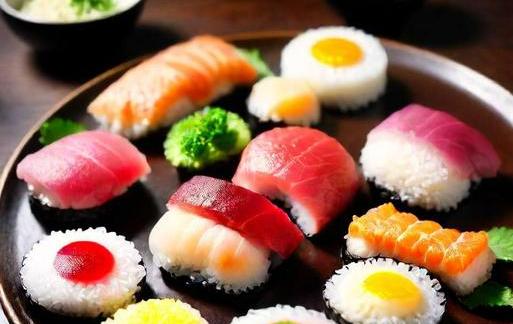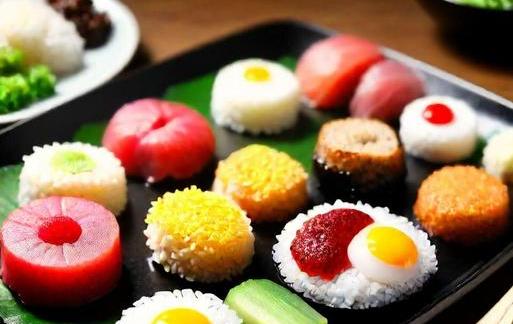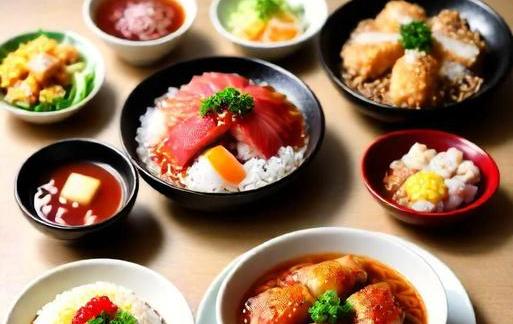- You are here:
- Home »
- Food
- » [REVEALED] Japanese Foods That Start With M
[REVEALED] Japanese Foods That Start With M
Note: This page contains affiliate links.
As an Amazon Associate, I earn from qualifying purchases when you click on the link, but you are not charged extra.
Japanese cuisine is renowned for its rich flavors, meticulous preparation, and diverse range of dishes. From sushi and sashimi to ramen and tempura, Japanese food has captivated the taste buds of people around the world. In this article, we will delve into the lesser-explored realm of Japanese foods that start with the letter “M”. These dishes showcase the culinary creativity and cultural diversity embedded in Japanese gastronomy. So, let’s embark on a flavorful journey through the world of Japanese foods beginning with the letter “M”.
Contents
- 1 List Of Japanese Foods That Start With M
- 1.1 1. Miso Soup (味噌汁 – Misoshiru)
- 1.2 2. Mochi (餅 – Mochi)
- 1.3 3. Matcha (抹茶 – Matcha)
- 1.4 4. Mizutaki (水炊き – Mizutaki)
- 1.5 5. Monjayaki (もんじゃ焼き – Monjayaki)
- 1.6 6. Matsutake (松茸 – Matsutake)
- 1.7 7. Mentaiko (明太子 – Mentaiko)
- 1.8 8. Mizuyokan (水羊羹 – Mizuyōkan)
- 1.9 9. Mikatahara Ringo (三方原りんご – Mikatahara Ringo)
- 1.10 10. Mizuna (水菜 – Mizuna)
- 2 Significance
- 3 Category-Related
- 4 Common Themes
- 5 Interesting Facts
- 6 Conclusion
List Of Japanese Foods That Start With M

1. Miso Soup (味噌汁 – Misoshiru)
Miso soup is a cornerstone of Japanese cuisine, enjoyed by people of all ages. This traditional Japanese soup features a savory broth made from fermented soybean paste called miso. Typically, it includes ingredients like seaweed, tofu, green onions, and sometimes fish or shellfish. Miso soup embodies the essence of umami, the fifth basic taste, making it a comforting and flavorful dish.
2. Mochi (餅 – Mochi)
Mochi, a versatile Japanese rice cake, has found its way into numerous aspects of Japanese culinary culture. Made from glutinous rice, mochi has a distinctive chewy texture. It can be enjoyed in various forms, including sweet and savory. Popular variations include daifuku, where sweet fillings like red bean paste are encased in mochi, and kinako mochi, coated with roasted soybean flour.
3. Matcha (抹茶 – Matcha)
While not a traditional food per se, matcha deserves a prominent place in Japanese cuisine. This finely ground green tea powder is not only consumed as a beverage but also incorporated into various dishes. Matcha-flavored desserts like matcha ice cream, matcha-flavored mochi, and matcha-flavored Kit Kats showcase its versatility and distinctive earthy flavor.
4. Mizutaki (水炊き – Mizutaki)
Mizutaki is a hot pot dish that originates from the Kyushu region. The name translates to "water boil," reflecting its preparation method. This communal dish involves simmering chicken, vegetables, and other ingredients in a savory broth. Diners can then dip the cooked ingredients into a ponzu or sesame-based dipping sauce, adding layers of flavor to each bite.
5. Monjayaki (もんじゃ焼き – Monjayaki)
Often overshadowed by its more famous counterpart, okonomiyaki, monjayaki is a Tokyo specialty that deserves recognition. This dish features a runny, pancake-like batter mixed with various ingredients such as cabbage, seafood, and meat. It is cooked on a griddle, and diners use tiny spatulas to consume the dish directly from the cooking surface. Monjayaki offers a unique and interactive dining experience.
6. Matsutake (松茸 – Matsutake)
Matsutake mushrooms are highly prized in Japanese cuisine for their distinct aroma and flavor. Considered a delicacy, these mushrooms are often featured in traditional kaiseki (multi-course) meals. Matsutake gohan, a rice dish cooked with matsutake mushrooms, exemplifies the subtle and earthy essence that this ingredient imparts to Japanese dishes.
7. Mentaiko (明太子 – Mentaiko)
Mentaiko, or spicy cod roe, is a popular and flavorful ingredient in Japanese cuisine. This marinated roe is often used as a filling for onigiri (rice balls) or incorporated into pasta dishes. The vibrant red color and intense umami taste make mentaiko a favorite among those who appreciate bold and distinctive flavors.
8. Mizuyokan (水羊羹 – Mizuyōkan)
Mizuyokan is a traditional Japanese sweet that showcases the artistry of wagashi (traditional Japanese confectionery). Made from red bean paste, agar-agar, and sugar, mizuyokan has a firm jelly-like texture. It is often molded into elegant shapes and enjoyed as a delicacy during tea ceremonies or as a sweet treat on special occasions.
9. Mikatahara Ringo (三方原りんご – Mikatahara Ringo)
Mikatahara Ringo, or Mikatahara apples, are a type of apple grown in the Mikatahara region of Japan. Known for their crisp texture and sweet, refreshing taste, these apples are a popular fruit in Japan. Whether enjoyed on their own or used in desserts and salads, Mikatahara Ringo adds a delightful touch to the country’s culinary landscape.
10. Mizuna (水菜 – Mizuna)
Mizuna is a leafy green vegetable commonly used in Japanese cuisine. With a mild, peppery flavor, mizuna is often included in salads, hot pot dishes, and pickles. Its tender leaves and stems contribute a unique texture and taste to various dishes, showcasing the diversity of vegetables in Japanese culinary traditions.
Exploring Japanese foods that start with the letter ‘M’ unveils a spectrum of flavors, textures, and culinary artistry. From comforting classics like miso soup and mochi to regional specialties like mizutaki and monjayaki, each dish reflects the meticulous attention to detail that defines Japanese gastronomy. Whether you’re a seasoned fan of Japanese cuisine or a newcomer eager to expand your palate, these ‘M’ dishes offer a tantalizing glimpse into the diverse and delicious world of Japanese food. So, the next time you find yourself in a Japanese restaurant or contemplating a culinary adventure, consider trying one of these ‘M’ delights for a truly authentic and memorable experience.
Significance

Japan, a nation renowned for its rich cultural heritage and culinary excellence, offers a diverse array of delectable dishes that tantalize the taste buds. In this exploration, we delve into the realm of Japanese cuisine, focusing specifically on foods that start with the letter “M”. From savory meals to delightful desserts, Japan has masterfully crafted a variety of ‘M’-named dishes that showcase the country’s culinary prowess. Join us on this gastronomic journey as we uncover the significance, categories, common themes, and intriguing facts behind these Japanese delights.
Understanding the significance of Japanese foods that start with ‘M’ requires a glimpse into the cultural, historical, and geographical aspects of Japan. Japanese cuisine, known as "washoku," emphasizes balance, seasonality, and artful presentation. Each dish reflects a harmonious blend of flavors, textures, and colors, often showcasing locally sourced and seasonal ingredients. The meticulous preparation and aesthetic presentation of Japanese dishes contribute to their global popularity.
As we narrow our focus to foods starting with “M”, we find that these items contribute to the intricate tapestry of Japanese culinary culture. From traditional meals deeply rooted in history to modern interpretations that reflect Japan’s global influence, these ‘M’-named foods offer a unique and flavorful experience.
Category-Related

Japanese foods that start with ‘M’ span various categories, including main courses, side dishes, snacks, and desserts. Let’s explore each category in detail, highlighting some iconic examples that captivate the senses:
Main Courses
-
Miso Soup:
- Description: A staple in Japanese cuisine, miso soup combines dashi (fish stock) with miso paste, tofu, seaweed, and additional ingredients like green onions and mushrooms.
- Significance: Often served as a starter, miso soup is not only flavorful but also provides essential nutrients. It reflects the simplicity and umami-rich nature of Japanese cooking.
-
Mackerel (Saba) Sushi:
- Description: Saba sushi features vinegared rice topped with marinated mackerel. The combination of the rice’s tanginess and the mackerel’s rich flavor creates a harmonious taste.
- Significance: Saba sushi exemplifies the art of sushi-making, showcasing the balance of textures and flavors that define this traditional Japanese dish.
Side Dishes
-
Mentaiko:
- Description: Mentaiko is marinated pollock or cod roe, often served as a side dish or used as a filling in onigiri (rice balls). The roe is seasoned with chili peppers, creating a spicy and savory profile.
- Significance: Mentaiko adds a burst of flavor to various dishes and snacks, demonstrating the Japanese penchant for transforming simple ingredients into culinary delights.
-
Nasu Miso (Miso-Glazed Eggplant):
- Description: Nasu miso involves grilling eggplants and smothering them in a savory miso glaze. The result is a dish with a delightful contrast between the smoky eggplant and the sweet-savory miso.
- Significance: This dish reflects the versatility of miso in Japanese cooking and introduces a unique way of preparing eggplants.
Snacks
-
Mochi:
- Description: Mochi is a glutinous rice cake that can be filled with various ingredients such as sweet red bean paste, ice cream, or fresh fruit. It boasts a chewy texture and is often enjoyed during special occasions.
- Significance: Mochi showcases the importance of rice in Japanese cuisine and the artistry involved in creating different textures within a single dish.
-
Mame Daifuku:
- Description: Mame daifuku consists of mochi stuffed with sweet red bean paste and a whole bean, typically a small adzuki bean. The combination of chewy mochi and the creamy sweetness of red bean makes it a delightful snack.
- Significance: Mame daifuku exemplifies the meticulous craftsmanship in Japanese sweets, where each element contributes to a harmonious flavor and texture profile.
Desserts
-
Matcha Ice Cream:
- Description: Matcha ice cream is a velvety dessert featuring the intense flavor of powdered green tea. It provides a perfect balance of sweetness and the distinctive bitterness of matcha.
- Significance: This dessert reflects the integration of traditional Japanese tea culture into modern cuisine, catering to both local and global palates.
-
Mont Blanc:
- Description: Mont Blanc is a chestnut-based dessert featuring a mound of chestnut puree topped with whipped cream. While not purely Japanese in origin, it has been embraced and adapted in the country.
- Significance: The popularity of Mont Blanc in Japan showcases the nation’s willingness to embrace and elevate foreign culinary influences, creating a delightful fusion of flavors.
Common Themes
While Japanese foods that start with ‘M’ may seem diverse, they often share common themes that tie them to the broader tapestry of Japanese cuisine:
-
Umami Excellence:
- Japanese foods, regardless of the ‘M’ factor, frequently highlight umami, the fifth basic taste. From miso in miso soup to the savory richness of mentaiko, umami plays a central role, contributing to the depth and complexity of flavors.
-
Seasonal Sensibility:
- Many ‘M’-named dishes showcase a keen awareness of seasonality. Ingredients like mushrooms in miso soup and chestnuts in Mont Blanc are chosen based on freshness and seasonal availability, aligning with the Japanese culinary philosophy.
-
Aesthetic Presentation:
- Whether it’s the vibrant colors of mame daifuku or the artful arrangement of ingredients in mackerel sushi, Japanese cuisine places a strong emphasis on visual appeal. The meticulous presentation of dishes elevates the dining experience to an art form.
Interesting Facts
-
Miso’s Centuries-Old Legacy:
- Miso, a key ingredient in miso soup, has been a staple in Japanese cuisine for over 1,300 years. Its production involves fermenting soybeans, rice, or barley with salt and koji (a type of fungus), showcasing the historical depth of Japanese culinary techniques.
-
Mochi Pounding Traditions:
- The preparation of mochi involves a unique tradition known as “mochitsuki”, where glutinous rice is pounded until it becomes a smooth, elastic mass. This process, often performed during special occasions and festivals, highlights the cultural significance of mochi in Japan.
-
Mackerel’s Nutritional Prowess:
- Mackerel, a common ingredient in sushi, is not only flavorful but also rich in omega-3 fatty acids, promoting heart health. Its inclusion in Japanese cuisine reflects a commitment to both taste and nutritional well-being.
-
Matcha’s Zen Connection:
- Matcha, the vibrant green tea powder used in matcha ice cream, has deep roots in Japanese tea ceremonies. It is associated with a sense of tranquility and mindfulness, showcasing the interconnectedness of culinary traditions and cultural practices.
Conclusion
Japanese foods that start with ‘M’ offer a captivating journey through the flavors, traditions, and innovations of Japanese cuisine. From the umami-rich depths of miso soup to the chewy delights of mochi, each dish tells a story of meticulous craftsmanship and cultural significance. As we savor the diverse array of ‘M’-named foods, we gain a deeper appreciation for the artistry that defines Japanese culinary excellence. Whether enjoyed in a traditional setting or embraced in modern interpretations, these culinary marvels continue to captivate palates around the world, inviting us to partake in the rich tapestry of Japanese gastronomy.


